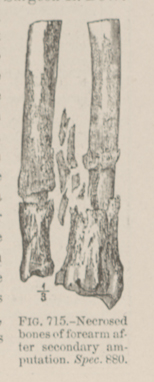Title: Green, W.
Source text: The Medical and Surgical History of the War of the Rebellion. (1861-65.), Part 2, Volume 2 (Washington, DC: Government Printing Office, 1876), 987.
Civil War Washington ID: med.d2e31369
TEI/XML: med.d2e31369.xml
CASE 1929.—Private W. Green, Co. C, 35th Massachusetts, aged 23 years, was wounded in the right forearm, at Antietam, September 17, 1862, and admitted to Capitol Hospital, Washington, six days afterward. Assistant Surgeon E. DeW. Breneman, U. S. A., contributed the specimen (FIG. 715), and reported the following history: "The ball entered the arm anteriorly one inch above the radio-carpal articulation, on radial aspect, fracturing that bone, and escaped posteriorly at the ulnar aspect, fracturing that bone also. The patient was admitted to Satterlee Hospital, October 12th, his arm in pasteboard splints. It was greatly tumefied and he was in intense pain. Placed the limb upon a straight splint, well padded, and had cold water constantly applied. On the evening of October 19th, secondary hæmorrhage supervened, presumed to be from the radial artery; the forearm was amputated by Acting Assistant Surgeon N. P. Hickman, by the circular method, at the middle third, by the advice of Assistant Surgeon J. S. Billings, U. S. A. I made an examination of the amputated portion and found a comminuted oblique fracture of the radius, commencing an inch from the articulation of the carpus; also a transverse fracture of the ulna, with the formation of a capsular ligament, thus producing a false joint; and a detached portion of the radius driven into the interosseous space and injuring the posterior interosseous artery, from which the hæmorrhage proceeded. Considerable callus was thrown out between the injured portions of each bone posteriorly, and at this part of the radius nature also made an attempt to form a capsular ligament. The radio-carpal articulation was uninjured." This patient was transferred to the care of Assistant Surgeon A. H. Smith, U. S. A., who reports, October 23rd, that "he had removed pieces of bone occasionally, and that the wound was nearly healed." The patient was discharged January 17, 1863, pensioned, and was paid September 4, 1875. The specimen (FIG. 715) shows the lower halves of the bones of the forearm, with necrosis of the fractured parts and slight osseous deposits above the lines of necrosis.
